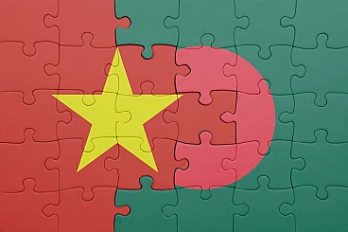Harry Wood | 21 January 2025
Bangladesh vs Vietnam: who leads the apparel market?

Harry Wood | 21 January 2025

DHAKA - In the global race to dominate the readymade garments (RMG) industry, Bangladesh has solidified its position as the world's second-largest exporter, overtaking Vietnam in several key metrics. A detailed analysis published in the 2024 Proceedings of the International Textile and Apparel Association (ITAA) highlights the factors underpinning this competitive edge, offering valuable insights into the dynamics of the RMG sector.
Authored by Md Rokibul Hasan from the University of Missouri, Sanjida Chowdhury Bonney from the Bangladesh University of Textiles, and Debanjan Das from West Virginia University, the study explores the economic impact and export competitiveness of Bangladesh and Vietnam within the global RMG landscape. Both nations are vital players, with Bangladesh exporting US$47bn worth of garments in 2023, a 10.27 per cent increase over the previous year. Vietnam, however, saw its exports dip by 9.09 per cent to US$40.bn, highlighting divergent trends in their respective industries.
Bangladesh's RMG sector is a cornerstone of its economy, contributing 10.35 per cent to its GDP and accounting for 84.58 per cent of total exports in the fiscal year 2022–2023. The industry employs approximately 4 million workers across over 4,600 factories, making up 36 per cent of the country’s manufacturing workforce. Meanwhile, Vietnam’s RMG sector, while crucial, constitutes a smaller share of its economy at 16 per cent of GDP and employs about 12 per cent of its industrial workforce.
The study attributes Bangladesh's superior performance to its ability to maintain low production costs and high export efficiency. While Vietnam boasts a more diverse industrial base and stronger pandemic management, it faces challenges such as rising labour costs, dependency on imported materials, and limited product range.
The research utilised several indices, including the Trade Competitiveness (TC) Index and the Normalised Revealed Comparative Advantage (NRCA), to assess the relative strengths of both countries. Bangladesh demonstrated a clear advantage with TC values consistently outperforming Vietnam's in key RMG product categories. The analysis revealed that Bangladesh achieved exclusive export advantages in many subcategories under Chapters 61 and 62 of the Harmonised System (HS), encompassing apparel and clothing accessories.
From 2011 to 2020, Bangladesh consistently maintained higher market shares in these categories, with notable growth in Chapter 62 products such as woven apparel. Vietnam, while competitive, struggled with comparative disadvantages in certain subcategories and faced a slower growth trajectory in market share.
The findings of the ITAA Proceedings show Bangladesh's ability to adapt to shifting global trade dynamics, including the "China plus one" strategy, which has driven international buyers to diversify their supply chains. While both nations benefit from this trend, Bangladesh's lower production costs and established infrastructure offer it a distinct edge.
The implications of this research extend beyond academic interest, serving as a strategic guide for policymakers, industry leaders, and investors. For Bangladesh, maintaining this momentum requires continued investment in worker welfare and sustainable practices to secure long-term growth. For Vietnam, addressing its weaknesses, such as dependency on imported raw materials and rising costs, could pave the way for regaining lost ground.
The full research is available in the ITAA Proceedings, Volume 81, accessible through the ITAA website.